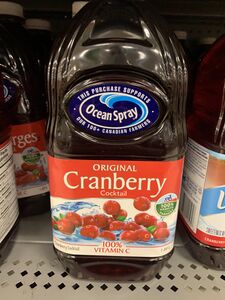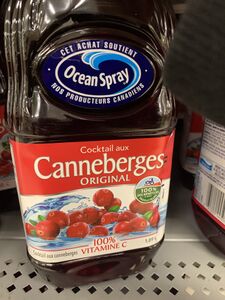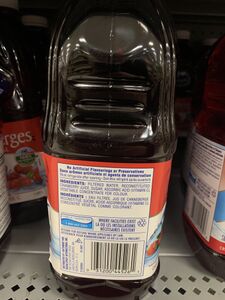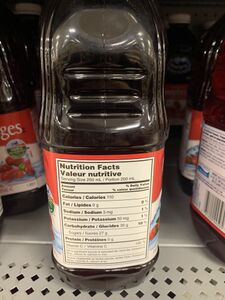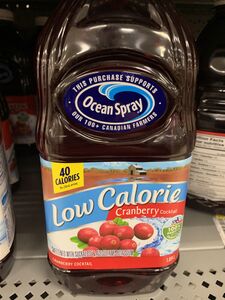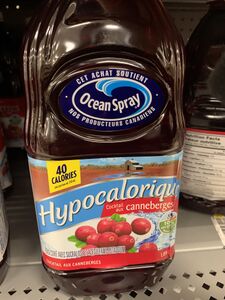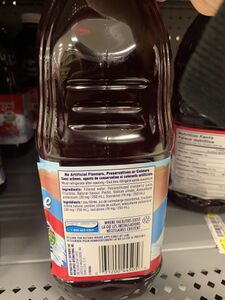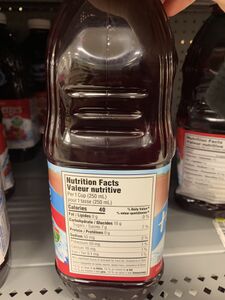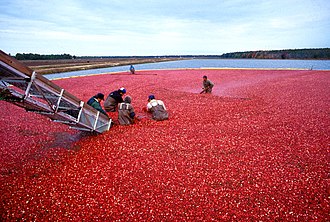Course:FNH200/Assignments/2021/Ocean Spray Cranberry Cocktail (Original VS Low Calorie)
Introduction
OceanSpray cranberry cocktails are a popular refresher among both children and adults during the summertime. As the general public is becoming more health-conscious, alternatives like the low calorie cranberry cocktail are readily available. We have chosen OceanSpray's cranberry cocktail and its low calorie version because we wish to investigate the underlying reasons for the different tastes and nutritional values. In this project, we explore the differences in the ingredients, roles of different substitutes and additives, and labelling requirements for each of these products.
At the end of this presentation you should be able to:
- Describe the differences in ingredients used
- Give details about the roles of the ingredients
- Identify which labels are necessary
- Recognize some of the fun facts
Product Photos
-
OceanSpray Cranberry Cocktail
-
French Label of OceanSpray Cranberry Cocktail
-
Ingredients of OceanSpray Cranberry Cocktail
-
Nutrition Facts of OceanSpray Cranberry Cocktail
-
OceanSpray Low Calorie Cranberry Cocktail
-
French Label of OceanSpray Low Calorie Cranberry Cocktail
-
Ingredients of OceanSpray Low Calorie Cranberry Cocktail
-
Nutrition Facts of OceanSpray Low Calorie Cranberry Cocktail
Ingredient Lists
| Ingredients | Food Identity | Functional Properties of Ingredients |
|---|---|---|
| Filtered water | Base ingredient | Filtered to mitigate microbiological hazards and to produce a more pleasant taste by reducing high mineral content [1] |
| Reconstituted cranberry juice | Base ingredient | Provides esters found in cranberries for aroma and taste [2] |
| Sugar (Sucrose) | Sweetening agent | A carbohydrate that provides a sweetness sensation [3] |
| Ascorbic acid (Vitamin C) | Additive (Preservative) | Acts as an antioxidant to reduce the rate of oxidation and to provide an acidic flavour [3] |
| Vegetable concentrate | Additive (Colouring agent) | Provides colour [4] |
| Ingredients | Food Identity | Functional Properties of Ingredients |
|---|---|---|
| Filtered water | Base ingredient | Filtered to mitigate microbiological hazards and to produce a more pleasant taste by reducing high mineral content [1] |
| Reconstituted cranberry juice | Base ingredient | Provides esters found in cranberries for aroma and taste [2] |
| Fructose | Sweetening agent | A carbohydrate that provides a sweetness sensation [3] |
| Natural flavour | Additive | Added to enhance cranberry flavouring and alters the natural status of the beverage [5] |
| Pectin | Additive (Emulsifying, gelling,
stabilizing, or thickening agent) |
Used as an emulsifying and stabilizing agent [2][6] |
| Sodium citrate | Additive (pH adjuster) | Used to buffer pH [2] |
| Acesulfame potassium (30mg/250mL) | Sugar substitute / Additive (Sweetener) | A non-caloric sweetener that provides a synergistic sweetening effect when used with another sweetener [7] |
| Sucralose (19mg/250mL) | Sugar substitute / Additive (Sweetener) | A non-caloric sweetener which provides a sweetness sensation to the beverage [7] |
Roles of fat substitutes, sugar substitutes, and/or additives:
Fat substitutes: Man-made or natural products that simulate the chemical and physical properties of fats and can be used to replace fat in foods. [8] These can be based on protein, carbohydrates, or fat and each of these have unique properties in terms of calories, taste, and texture. [8] Protein-based fat substitutes are partially digested (1 to 1.3 Calories per gram) and give a creaminess and richness of fat. [8] Carbohydrate-based fat substitutes, on the other hand, are fully digestible (4 Calories per gram) and gives a smooth, but bland mouthfeel. [8] While fat-based fat substitutes are indigestible (0 Calories per gram) and give a rich and creamy texture. [8]
Sugar substitutes: Man-made or natural products that simulate the chemical and physical properties of sugar. Lesser amounts of sugar substitutes can be used if they are not bulk sweeteners due to their intense sweetness profiles. [8] These sugar substitutes can range from 100-600x as sweet as sucrose when used in the same amounts. [8] The 2 types of sugar substitutes are caloric sweeteners (4 Calories per gram) and non-caloric sweeteners (0 Calories per gram). [8] These can be used for weight loss, reduce the likeliness of developing dental caries, and can be used for diabetics if the sugar substitute does not affect blood glucose/insulin levels. [8]
Additives: Substances that affect the characteristics of food when added. [9] They must meet one or more of the following conditions as outlined by the Food and Agriculture Organization: [10]
- To preserve the nutritional quality of the food
- To provide necessary ingredients for foods manufactured for consumers having special dietary needs
- To enhance the stability of food (cannot change the nature, substance, or quality of the food to deceive the consumer)
- To provide aid in the manufacturing to the storage of food (additive should not be used to disguise undesirable or unhygienic practices)
Compare and Contrast
Base ingredients:
As shown above, cranberry cocktail and the low calorie cranberry cocktail share some of the same ingredients. Included in this list are filtered water and reconstituted cranberry juice. Both products use water and reconstituted cranberry juice as a base ingredient, with the latter contributing a cranberry flavour.
Sweeteners:
Cranberry cocktail and the low calorie alternative have different sweeteners. Cranberry cocktail uses sucrose (sugar) as its only sweetener. Sugar (sucrose - composed of 1 molecule of glucose joined together to 1 molecule of fructose) gives the product a sweet taste but has more calories than the low calorie alternatives. [3] The low calorie cranberry cocktail uses two non-caloric sugar substitutes, sucralose paired with acesulfame potassium, to create a drink that retains a palatable sweetness level while being lower in calories. [3] In addition, fructose, another sweetening agent which has a higher sweetening power compared to sucrose, contributes to the sweetness level with a minimal increase in calories. [3]
Additives:
Other differences in these two products are the ascorbic acid (vitamin C) that is added to the cranberry cocktail, but not to the low calorie version. It is used as an antioxidant and provides an acidic/sour flavour. [3] An antioxidant like ascorbic acid is needed because the reconstituted cranberry juice contains fruit sugars, which can cause browning reactions, such as Maillard browning, to occur. [3][11] Lastly, the vegetable concentrate is used to provide colour as noted in the list of ingredients label.[4]
In contrast, sodium citrate in the low calorie cranberry cocktail acts to buffer pH as per good manufacturing practice. [2] Sodium citrate is a strong reducing agent and protects the reconstituted cranberry juice fruit sugars, such as fructose, from participating in browning reactions. [3][11][12] Natural flavouring is added to the low calorie version to enhance cranberry flavouring, offset other flavours, and impart aftertaste that might arise from the sugar substitutes and sweeteners. [5][13] Finally, pectin is used to emulsify and stabilize all ingredients in the low calorie cranberry cocktail as it contains many more ingredients than the cranberry cocktail. [2]
| Ingredients | Cranberry Cocktail (Original) | Cranberry Cocktail (Low Calorie) |
|---|---|---|
| Filtered water | ✓ | ✓ |
| Reconstituted cranberry juice | ✓ | ✓ |
| Sugar (Sucrose) | ✓ | |
| Ascorbic acid (Vitamin C) | ✓ | |
| Vegetable concentrate | ✓ | |
| Fructose | ✓ | |
| Natural flavour | ✓ | |
| Pectin | ✓ | |
| Sodium citrate | ✓ | |
| Acesulfame potassium (30mg/250mL) | ✓ | |
| Sucralose (19mg/250mL) | ✓ |
Labels
| Cranberry Cocktail (Original) | Cranberry Cocktail (Low Calorie) | |
|---|---|---|
| Fortification | There is added ascorbic acid (vitamin C) | Does not contain any added vitamins or minerals |
| Nutrient content claims or diet related health claims | Does not contain any | Contains "low calorie" on the label
Adheres to Health Canada's requirement of having 40 calories or less per reference amount and serving of stated size [15] |
| Bilingual labelling | English and French (the two official languages of Canada) | |
| Common name of food | Cranberry Cocktail | |
| Country of origin | United States of America | |
| Date marking/storage instructions (only if storage life is 90 days or less) | These products have a storage life of longer than 90 days, however the best before date is marked on the bottles
Expiration dates allow consumer peace of mind through inferring the freshness of the product via the expiration date [9] | |
| Identity and principal place of business | OceanSpray International Inc. One OceanSpray Drive Lakeville-Middleboro, MA, USA | |
| Irradiated foods | These products are not irradiated therefore no labels are required | |
| Legibility and location | All labels are clearly shown and legible and placed appropriately on the product (front/back/sides) | |
| List of ingredients and allergens | Clearly labelled on the side of the product | |
| Nutrition facts table | Contains all the required information (calories, fat (saturated and trans fat), cholesterol, sodium, carbohydrate, fibre, sugar, protein, calcium, iron, and vitamin A/C as well as serving size) | |
| Net quantity of food | Clearly labelled on the products front and back (1.89L) | |
| Sweeteners | Clearly identified in the list of ingredients and an additional label on the front of the low calorie product | |
| Food additives | Identified in the list of ingredients | |
| Other mandatory information | No other mandatory information required for these products | |
Both products meet the labelling requirements as enforced by the Canadian Food Inspection Agency.
Fun Facts
- The fruit is named "cranberry" because the flower, stem, calyx, and petals of the shrubs were found to resemble the neck, head, and bill of a Sandhill Crane. [16]
- Cranberries don't actually grow underwater! They appear so because of wet harvesting, a method where the bog is flooded. [17]
- Beware of a bowl of cranberries at a party - the distant relative of the cranberry is the holly berry, bearing a similar appearance. But it is in fact dangerous to ingest in high amounts due to the ilicin as it can lead to nausea, vomiting, and diarrhea. [18]
- Cranberries are not usually eaten without processing, as it is a very acidic food with a low pH of 2.3-2.5, similar to the lemon, with a pH of 2-3. [19][20]
- Cranberry juice is widely used for the prevention of urinary tract infections. [21]
- Proanthocyanidin, a precursor of anthocyanidin (contributes to the cranberry's pigment), may have anti-carcinogenic effects. [21]
-
Sandhill crane
-
Wet harvesting of cranberries
-
Cranberries
-
Holly berries
References
- ↑ 1.0 1.1 "Water for use in the preparation of food". Government of Canada. July 23, 2018. Retrieved July 20, 2021.
- ↑ 2.0 2.1 2.2 2.3 2.4 2.5 "Food and Drug Regulations (C.R.C., c. 870) Page 74". Justice Laws Website. July 12, 2021. Retrieved July 20, 2021.
- ↑ 3.0 3.1 3.2 3.3 3.4 3.5 3.6 3.7 3.8 Skura, Brent; Liceaga, Andrea; Li-Chan, Eunice; et al. (July 4, 2021). "Chemical and Physical Properties of Food". UBC Wiki. Retrieved July 20, 2021. Explicit use of et al. in:
|last=(help)CS1 maint: multiple names: authors list (link) - ↑ 4.0 4.1 "Cranberry Cocktail". OceanSpray. 2021. Retrieved July 21, 2021.
- ↑ 5.0 5.1 "Nature, natural - Method of production claims on food labels". Government of Canada. March 8, 2019. Retrieved July 20, 2021.
- ↑ "4. List of Permitted Emulsifying, Gelling, Stabilizing or Thickening Agents (Lists of Permitted Food Additives)". Government of Canada. April 13, 2021. Retrieved July 20, 2021.
- ↑ 7.0 7.1 "9. List of Permitted Sweeteners (Lists of Permitted Food Additives)". Government of Canada. September 1, 2020. Retrieved July 20, 2021.
- ↑ 8.0 8.1 8.2 8.3 8.4 8.5 8.6 8.7 8.8 Skura, Brent; Liceaga, Andrea; Li-Chan, Eunice; et al. (July 16, 2021). "Fat and Sugar Substitutes - Sensory Perception of Foods". UBC Wiki. Retrieved July 20, 2021. Explicit use of et al. in:
|last=(help)CS1 maint: multiple names: authors list (link) - ↑ 9.0 9.1 Skura, Brent; Liceaga, Andrea; Li-Chan, Eunice; et al. (June 24, 2020). "Food Standards, Regulations and Guides - Food Additives". UBC Wiki. Retrieved July 17, 2021. Explicit use of et al. in:
|last=(help)CS1 maint: multiple names: authors list (link) - ↑ World Health Organization, Food and Agricultural Organization of the United Nations (2019). Codex Alimentaruis International Food Standards. United Nations and World Health Organization. pp. 2–3.
- ↑ 11.0 11.1 Clemens, Roger; Drewnowski, Adam; et al. (March 2017). "Squeezing Fact from Fiction about 100% Fruit Juice". Adv Nutr. 6(2): 236S–243S – via PubMed Central. Explicit use of et al. in:
|last3=(help) - ↑ "Sodium citrate: Uses, Interactions, Mechanism of Action". DrugBank. July 18, 2021. Retrieved July 21, 2021.
- ↑ Céline, Riera (August 2017). "Artificial sweeteners and salts producing a metallic taste sensation activate TRPV1 receptors". Am J Physiol Regul Integr Comp Physiol. 293(2): 626–634 – via National Center for Biotechnology Information.
- ↑ "Food labelling for industry". Government of Canada. January 15, 2019. Retrieved July 17, 2021.
- ↑ "C.R.C., c. 870 Page 27". Justice Laws Website. June 23, 2021. Retrieved July 21, 2021.
- ↑ "How did the cranberry get its name?". Massachusetts Cranberries. Retrieved July 20, 2021.
- ↑ "About the Harvest". OceanSpray. 2021. Retrieved July 20, 2021.
- ↑ "Are Holly Berries Poisonous to Humans & Animals?". Nature Hills. February 6, 2017. Retrieved July 21, 2021.
- ↑ Vera, Kathryn (November 27, 2018). "Is Cranberry Juice Acidic or Alkaline?". SFGate. Retrieved July 20, 2021.
- ↑ Petre, Alina (December 2, 2016). "Lemon Juice: Acidic or Alkaline, and Does It Matter?". Healthline. Retrieved July 20, 2021.
- ↑ 21.0 21.1 Therapeutic Research Center (February 20, 2021). "Cranberry". Natural Medicines. Retrieved July 20, 2021.
| This Food Science resource was created by Course:FNH200. |
